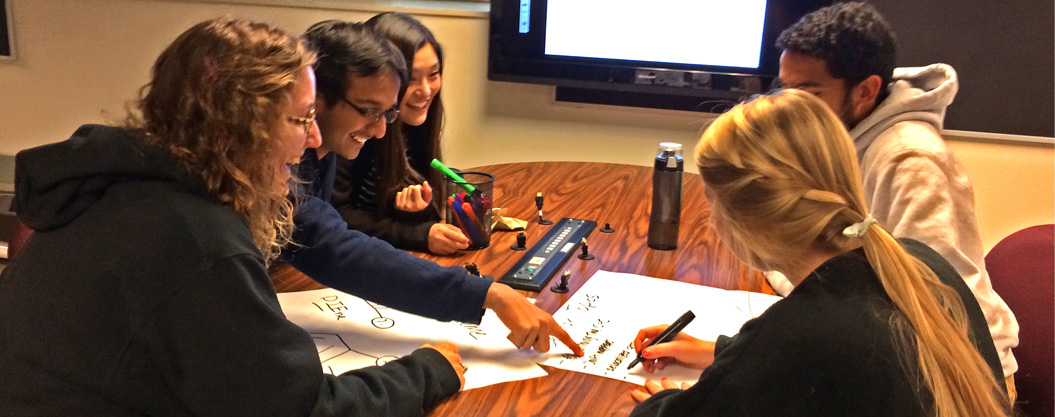Chemical Education
 |
 |
Research Areas
What is Chemical Education Research?
- Inclusivity and Social Belonging
- Student Cognition/Metacognition
- Collaborative Learning Approaches
- Faculty Development
Seminar Course
All graduate students are required to take 2 credits of a seminar course in either the fall or spring semester of their first year. Students whose primary research area is Chemical Education Research will register for the seminar course in their chosen primary foundational track. However, they will attend the STEM Education Research seminars that are held during the academic year between education researchers in the College of Science and the College of Education. In addition, their departmental seminar in their second year will be given in the fall in this STEM Education Research seminar series.
Course Requirements
Students in the Chemistry Education Research track will choose a primary foundational area (among Analytical, Biological, Organic, Inorganic, or Physical) for curriculum purposes, in addition to the Chemical Education primary research area. All of our students must complete at least eight half-semester courses in the first year.
Students are required to take at least 4 courses from the foundational-area track of their choice. For the complete list of the courses available for each track, see the Graduate Handbook. Courses available for each track in the fall and spring semesters are shown here.
Students in the Chemistry Education Research track are required successfully complete the following three courses:
- CHEM 7360 Chemical Education Research (2 credits)
- Social Science (Behavioral Science) Statistics courses: SOC 6120 (Statistics 1) and SOC 6130 (Statistics II) in the College of Social and Behavior Sciences, or a similar year-long social-science and behavioral sciences statistics course series.
Note: These two 3-credit statistics courses are each a semester long, for a total combined 6 credits, which is equivalent to three half-semester graduate courses. These statistics courses are taught in a different College. However, these courses will count towards Chemical Education Research students’ credits because the College of Science does not presently offer an equivalent course.
Faculty

Gina F. Frey
Chemistry Education developing active-learning and collaborative strategies.
Phone: (801) 581-4268
Office: 4402 Thatcher Building

Janis Louie
Discovery and development of transition metal-mediated reactions for the catalytic construction of structurally complex small molecules and polymeric materials.

Thomas G. Richmond
What is Chemistry Education Research?
Chemistry education research (CER) is the scientific study of the teaching and learning
of chemistry. Chemical education researchers aim to improve student learning, retention,
and belonging in the field of chemistry by applying concepts from educational, cognitive,
and social psychology to chemistry learning environments. CER is conducted both in
the field (i.e., in a classroom setting) and in controlled laboratory settings. Topics
studied in CER are wide ranging. Cognitive areas of research focus on students internal
learning processes, such as the impact of specific teaching methods (e.g., active
learning, collaborative group work) on student learning, the impact of misconceptions
on student learning and how to correct these misconceptions, how to improve student
problem solving in STEM, how to improve long-term retention and transfer of learning
across chemistry courses, and the development of students’ metacognitive skills. Social
psychological areas of research consider the impacts of the social setting and learning environment on students’ experiences in chemistry, such as students’
social belonging, the inclusivity of the course, or the effects of teaching methods
on different demographics of students. In addition to studying outcomes for students,
chemistry education researchers also develop and validate instruments, such as assessments,
surveys, observation protocols, to measure different variables of interest (e.g.,
understanding, belonging, metacognition) as well as analytical methodologies (i.e.,
statistical methods) for assessing relationships between measured variables.
setting and learning environment on students’ experiences in chemistry, such as students’
social belonging, the inclusivity of the course, or the effects of teaching methods
on different demographics of students. In addition to studying outcomes for students,
chemistry education researchers also develop and validate instruments, such as assessments,
surveys, observation protocols, to measure different variables of interest (e.g.,
understanding, belonging, metacognition) as well as analytical methodologies (i.e.,
statistical methods) for assessing relationships between measured variables.
CER uses both quantitative and qualitative methods depending on the research questions
being asked. In the quantitative studies, numerical data are analyzed using a variety
of statistical methods, and often examine a comparison of knowledge, skills, performance,
and affective measures. However, it is often difficult to fully understand human behaviors
and experiences with quantitative methods, alone. Therefore, researchers also use
qualitative methods to provide insight into underlying meanings and patterns in the
data that often cannot be determined by quantitative methods. Qualitative data can
include interviews, focus groups, responses to opened-ended survey questions, reflections,
observations, etc. Quantitative methods are useful for detecting and modeling patterns
in students’ outcomes (e.g., How do hours studied before an exam impact students’
exam grades?) whereas  qualitative methods are useful for establishing a theory of how and why patterns are
observed (e.g., What are students doing during their study hours that leads to better
exam performance?). Often, quantitative and qualitative methods are coupled to best
understand the collected data. Mixed-methods studies are those that combine quantitative
and qualitative methods and are common in CER.
qualitative methods are useful for establishing a theory of how and why patterns are
observed (e.g., What are students doing during their study hours that leads to better
exam performance?). Often, quantitative and qualitative methods are coupled to best
understand the collected data. Mixed-methods studies are those that combine quantitative
and qualitative methods and are common in CER.
Teaching and learning, particularly in large classroom settings, are remarkably complex social and cognitive activities, leading to a broad range of research questions and types of studies being conducted in CER. Consider a single teacher in a classroom with 100 students. Each student has a unique, individual experience with the teacher, with their fellow classmates, with the course content, and with their own identity as part of the broader science community. Even in this highly simplified scenario, there are countless social and psychological variables and interactions that shape each students’ experience and effect their performance, retention, and belonging in chemistry and STEM. Research in this setting must consider the content of the course (chemistry), the internal, cognitive and psychological processes of the students, and the social influences of the people and culture of the course and broader science community. Hence, CER is inherently an interdisciplinary field integrating ideas and methodologies from fields such as chemistry, psychology, statistics, sociology, and education (learning sciences). To address these complex, interdisciplinary problems, researchers in the CER program at the University of Utah work collaboratively with chemistry and other STEM instructors, researchers in physics education, experts in psychology (cognitive and social), the university’s Center for Science and Mathematics Excellence (CSME), and the university’s College of Education.

